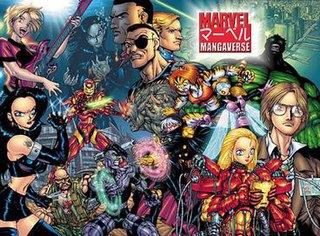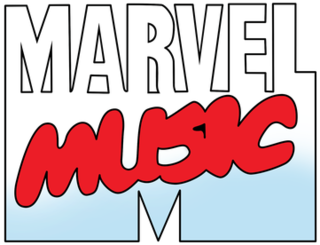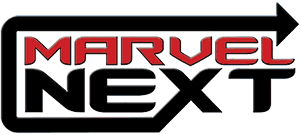 W
WAmalgam Comics was a publishing imprint shared by DC Comics and Marvel Comics, in which the two comic book publishers merged their characters into new ones. These characters first appeared in a series of 12 comic books which were published in April 1996, between Marvel vs. DC #3 and DC vs. Marvel #4, the last two issues of the DC vs. Marvel crossover event. A second set of 12 comic books followed one year later in June 1997, but without the crossover event as a background. All 24 of these issues occurred between the aforementioned issues of DC vs. Marvel.
 W
WAtlas Comics is the 1950s comic-book publishing label that evolved into Marvel Comics. Magazine and paperback novel publisher Martin Goodman, whose business strategy involved having a multitude of corporate entities, used Atlas as the umbrella name for his comic-book division during this time. Atlas evolved out of Goodman's 1940s comic-book division, Timely Comics, and was located on the 14th floor of the Empire State Building.
 W
WCross Generation Entertainment, or CrossGen, was an American comic book publisher and entertainment company that operated from 1998 to 2004. The company's assets were acquired by The Walt Disney Company in 2004, and designated to Disney Publishing Worldwide. In July 2010, Disney re-established the brand through Marvel Comics, who announced plans to revive CrossGen titles.
 W
WEternity Comics was a California-based comic book publisher active from 1986 to 1994, first as an independent publisher, then as an imprint of Malibu Comics. Eternity published creator-owned comics of an offbeat, independent flavor, as well as some licensed properties. Eternity was also notable for reprinting foreign titles, and introducing Cat Claw, The Jackaroo, and the Southern Squadron to the U.S. market.
 W
WIcon Comics is an imprint of Marvel Comics for creator-owned titles, designed to keep select "A-list" creators producing for Marvel rather than seeing them take creator-owned work to other publishers.
 W
WMalibu Comics Entertainment, Inc. was an American comic book publisher active in the late 1980s and early 1990s, best known for its Ultraverse line of superhero titles. Notable titles under the Malibu label included The Men in Black, Ultraforce, Night Man and Exiles.
 W
WMarvel 2099 is a Marvel Comics imprint, started in 1992, that was originally one possible future of the Marvel Universe, but later revealed in a climax of Superior Spider-Man Goblin Nation arc and Amazing Spider-Man Vol. 3 #14 to be the Earth of the prime Marvel continuity in the distant future. It was originally announced by Stan Lee in his "Stan's Soapbox" column as a single series entitled The Marvel World of Tomorrow, which was being developed by Lee and John Byrne. This later changed to a line of books under the banner Marvel 2093 before finally being published as Marvel 2099.
 W
WMarvel Press is the prose novel imprint for Marvel Comics jointly published with Disney Books.
 W
WThe Marvel Mangaverse is a series of comic books published by Marvel Comics from 2000 to 2002, with a sequel "New Mangaverse" released in late 2005 and early 2006.
 W
WMarvel Music was a short-lived imprint of Marvel Comics, introduced in 1994 to publish comics developed in collaboration with musicians.
 W
WMarvel Next was a short lived imprint that was launched by the American comics publisher Marvel Comics in early 2005. Marvel's press release stated that Marvel Next was "not a new line or imprint" but rather "a collection of titles" intended to "spotlight young characters." Like the Tsunami imprint before it, it aimed to attract young readers. Marvel Next titles carried a "Marvel Next" tag on the cover, but not always in the typical imprint location near the regular Marvel logo. The title may have been an attempt to appeal to or identify with Generation Next.
 W
WMarvel Press is the prose novel imprint for Marvel Comics jointly published with Disney Books.
 W
WMarvel Unlimited, formerly known as Marvel Digital Comics Unlimited, is an online service by Marvel Comics that distributes past issues of their comics via the internet. The service launched on November 13, 2007, and now has more than 27,000 issues in its archive.
 W
WMAX Comics is an imprint of Marvel Comics specializing in comic book media aimed at adult-only readers. It was launched in 2001 after Marvel broke with the Comics Code Authority and established its own rating system.
 W
WStar Comics was an imprint of Marvel Comics that began in 1984 and featured titles that were aimed at child readers and were often adaptations of children's television series, animated series or toys. The last comic published under the imprint featured a May 1988 cover date, although the Star Comics Magazine continued through December 1988. Some of the titles continued after that, being published directly by Marvel. Several of the original titles consciously emulated the house writing and visual style of then-recently defunct Harvey Comics titles such as Richie Rich.
 W
WTimely Comics is the common name for the group of corporations that was the earliest comic book arm of American publisher Martin Goodman, and the entity that would evolve by the 1960s to become Marvel Comics.
 W
WUltimate Marvel, later known as Ultimate Comics, was an imprint of comic books published by Marvel Comics, featuring re-imagined and modernized versions of the company's superhero characters from the Ultimate Marvel Universe. Those characters include Spider-Man, the X-Men, the Ultimates, the Fantastic Four and others. The imprint was launched in 2000 with the publication of the series Ultimate Spider-Man and Ultimate X-Men followed by The Ultimates and Ultimate Fantastic Four in 2002 and 2004 respectively providing new origin stories for the characters. The reality of Ultimate Marvel is designated as Earth-1610 as part of the Marvel Comics Multiverse.